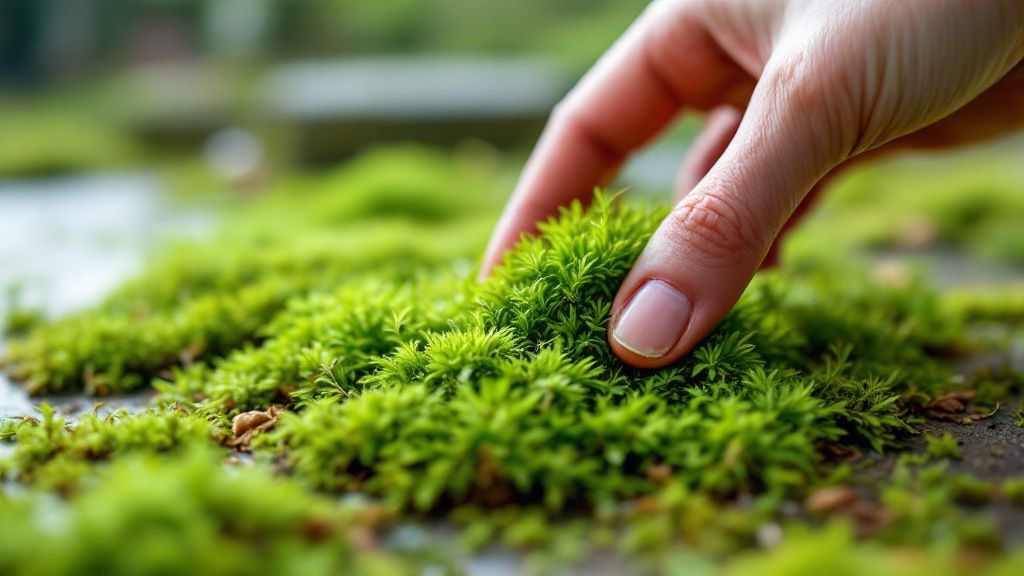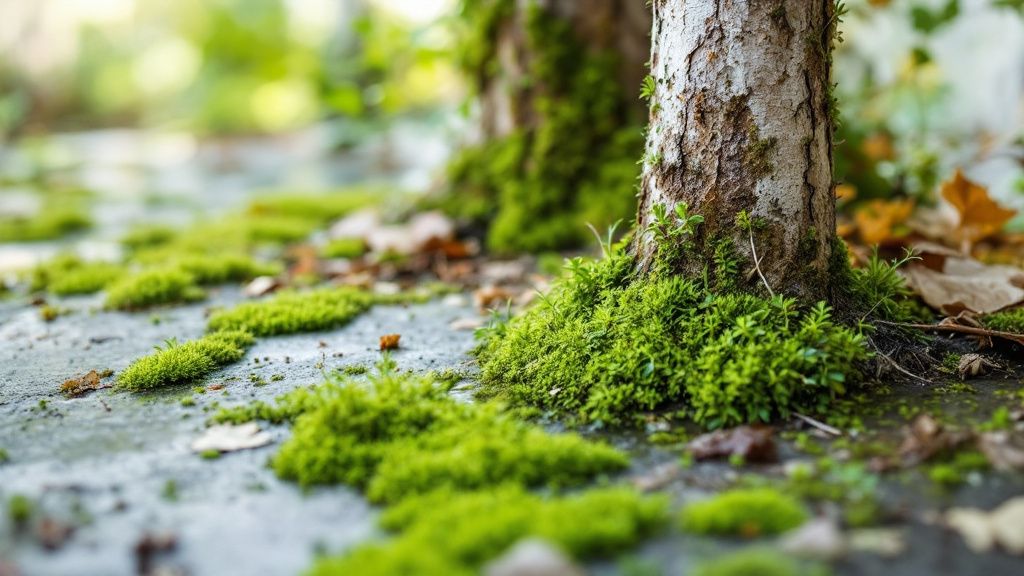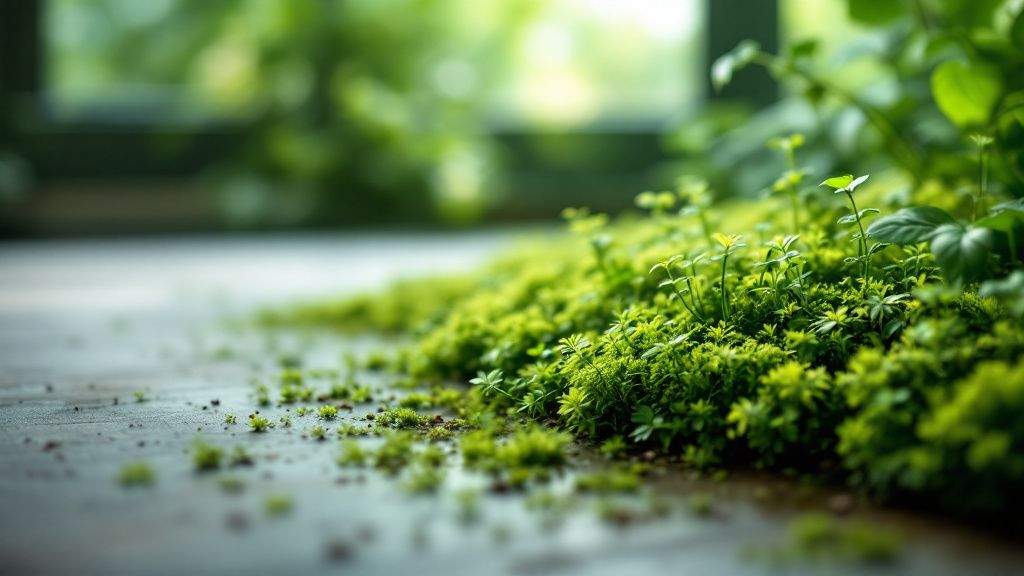Keeping moss out of your house begins with addressing the key conditions that allow it to thrive. You need to focus on reducing moisture in areas prone to moss emergence. Regularly ventilate rooms by opening windows to encourage air circulation, which helps decrease dampness. Ensuring that areas like your basement and bathroom remain dry can significantly deter moss infestations. Seal any cracks or spaces where moisture can seep indoors. Consistent surveillance in less visible areas, such as behind furniture or in corners, can prevent the spread of moss. Employing natural moss cleaning solutions, including vinegar or essential oils, can maintain surfaces without harsh chemicals, making sure these are part of your routine cleaning. By understanding how to prevent moss, you reduce the need for extensive moss removal methods.
Alongside preventing excess moisture, keep living spaces brightly lit, since moss tends to flourish in shaded and damp conditions. When possible, rearrange furniture to allow light to reach areas that usually remain in the dark. Keep an eye on potted plants inside your home as they can harbor moss; ensure proper drainage and avoid water buildup at the saucers beneath pots. These simple but effective preventive strategies can diminish the likelihood of moss in the house, thereby lessening the need for pressure washing moss or hiring moss cleaning services.
Understanding Moss Growth: Conditions and Causes
Moss tends to flourish in environments that are damp and shaded, making these the main culprits in indoor moss growth. It thrives in moisture-rich areas with poor air circulation, such as basements, attics, or rarely used rooms. You can often find it growing on surfaces that remain consistently damp, indicating a persistent humidity issue.
Scientifically, moss is a non-vascular plant that absorbs water and nutrients through its leaves. According to recent studies, the lack of direct sunlight coupled with high humidity levels creates the conditions for its proliferation. Understanding these variables can help inform how to prevent moss effectively indoors.
Temperature also plays a pivotal role in moss growth. Cooler environments where temperatures remain constant and damp provide a comfortable habitat for moss. If you notice moss in the house, it could signal inadequate ventilation or potential leaks that need to be addressed.
Taking proactive measures to control these conditions helps curtail the potential for moss infestations. Regularly maintaining your home’s humidity levels and ensuring bright environments are some of the best ways to get rid of moss issues before they necessitate complex moss cleaning solutions.
Maintaining Optimal Indoor Conditions
Controlling indoor humidity levels is essential to prevent moss from gaining a foothold. Using a dehumidifier in your home is an effective method to keep moisture under control. Additionally, you should ensure that damp-prone areas are promptly dried, and exhaust fans are utilized in bathrooms and kitchens to disperse excess moisture from daily activities.
What most people don’t see about maintaining a moss-free home is the consistent effort required to monitor and adjust environmental conditions that might invite unwanted growth. Regularly checking for leaks or drips in plumbing can prevent unexpected moisture build-up, a common catalyst for moss invasions.
Maintaining adequate lighting is another preventive measure. By arranging furniture to maximize natural light or utilizing lamps effectively, you can create less favorable conditions for moss growth. Light fixtures should be strategically placed to ensure the usually shadowed regions are exposed adequately to deter moss.
Proper air circulation is key to keeping indoor spaces dry and mold-resistant. Opening windows when the weather permits and using portable fans to enhance airflow helps maintain conditions that discourage moss. These strategies, alongside regular cleaning routines, form essential components in how to prevent moss, thereby reducing reliance on more labor-intensive moss removal options like pressure washing or professional moss cleaning services.
Choosing the Right Houseplants
Selecting houseplants that are naturally resistant to mold and mildew is a smart strategy to keep moss at bay. Opt for succulents or plants like snake plants, which thrive in low-moisture environments. These plants emit less humidity than their counterparts, reducing conditions conducive to moss emergence.
Comparing humidity-loving ferns with moisture-resistant peace lilies highlights how critical plant choice can be. While ferns can inadvertently increase indoor dampness, peace lilies help purify the air without adding excess moisture. Choosing the right plants prevents unnecessary moss cleaning efforts by eliminating moisture traps inside your home.
Keeping plants in well-drained pots is vital for preventing water accumulation, which can encourage moss in the house. Ensure that the saucers under plant pots are emptied regularly, preventing stagnant water. This small adjustment in plant care can serve as an effective step in how to prevent moss, minimizing the need for extensive moss removal methods or consulting moss cleaning services.
Cleaning Surfaces Susceptible to Moss
Consistently cleaning surfaces that are prone to moss growth is essential to maintaining a moss-free home. Focus on areas such as bathroom tiles, window sills, and basements, where moisture tends to linger. Regular cleaning with natural moss cleaning solutions like vinegar can be effective in how to clean moss off these surfaces. Pressure washing certain exterior tiles or patios can also be one of the best ways to get rid of moss outside your home.
Tracing its evolution from ancient use in gardens to modern challenges in home maintenance, the battle against moss has persisted through the ages. In bygone eras, people utilized natural remedies that persist today, emphasizing the timelessness of these approaches. Incorporating such historical methods—like using lime or baking soda—into your cleaning regimen can boost moss removal efforts, minimizing dependency on moss cleaning services.
Maintain meticulous attention to detail when drying and airing out spaces after cleaning to prevent moss from returning. Moisture control, alongside strategic use of ventilation, enhances the longevity of your cleaning efforts. By understanding how to prevent moss effectively, you solidify techniques that ensure surfaces remain clean and resistant to growth over time.
Regular Inspection and Maintenance
Regular inspection and maintenance play a crucial role in keeping moss out of your home. By conducting weekly checks of damp-prone areas such as basements, bathrooms, and kitchens, you can spot potential moss issues before they escalate. Keep an eye out for signs of dampness or discoloration on walls and surfaces, as these might indicate a need for early moss removal.
While many believe that addressing moss only when visible is effective, there’s a strong case for proactive inspections to prevent its growth entirely. Early detection through routine checks allows you to employ moss cleaning solutions and simple maintenance tasks that preempt the need for pressure washing moss or employing moss cleaning services.
During inspections, pay attention to areas around windows, behind furniture, and the corners of rooms. Checking seals and ensuring proper ventilation can prevent the conditions in which moss thrives. Regular maintenance, including fixing leaks and ensuring adequate insulation, is key as well. Understanding how to prevent moss proactively safeguards your home environment, reducing both time and cost in managing these unwanted visitors.
Dealing with Moss-Proofing Challenges
Facing moss-proofing challenges can be daunting, especially in damp and shaded environments. Identifying the most vulnerable spots in your home and tailoring specific moss removal tactics can be essential. Consider using specialized moss cleaning solutions for persistent areas and improving structural elements like drainage and airflow to prevent regrowth.
In the next few years, advancements in home technology are likely to enhance our ability to maintain moss-free living spaces. Innovations in humidity control systems and smart home features could provide new, effective ways to prevent moss growth. These future solutions may refine how you approach the best ways to get rid of moss throughout your home.
Managing challenges involves tackling them head-on with a combination of traditional and modern techniques. Employing pressure washing moss for stubborn spots while using preventive measures, such as applying protective coatings on surfaces, can cover a wide range of issues. Understanding these difficulties ensures that you remain prepared and resilient against moss in the house, enabling you to seek the best combination of strategies and tools for enduring success.






